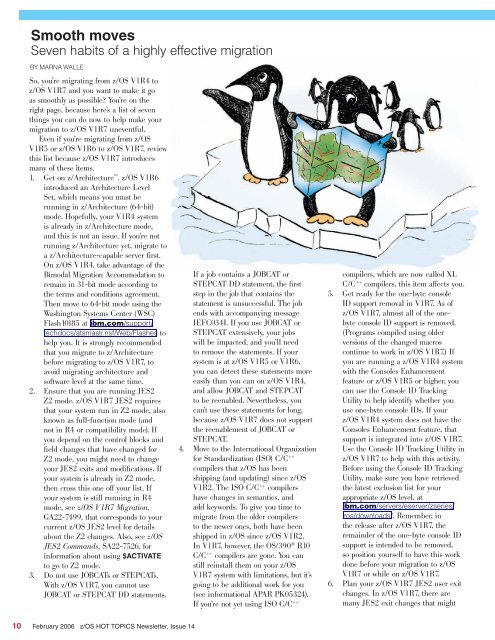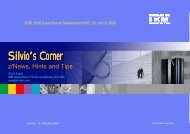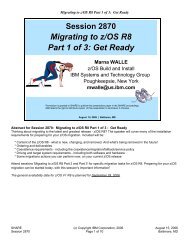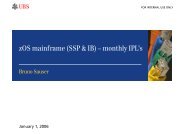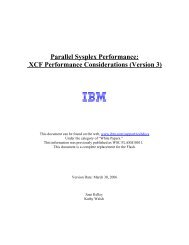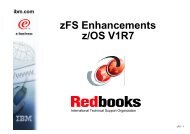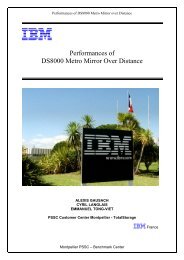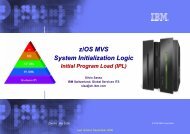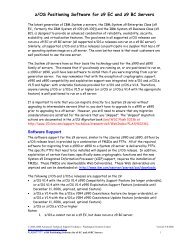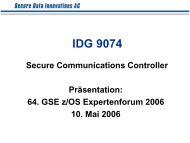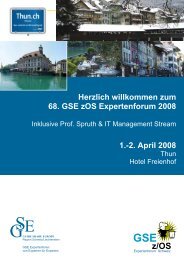Hot Topics - Messmer The Brain House
Hot Topics - Messmer The Brain House
Hot Topics - Messmer The Brain House
Create successful ePaper yourself
Turn your PDF publications into a flip-book with our unique Google optimized e-Paper software.
Smooth moves<br />
Seven habits of a highly effective migration<br />
BY MARNA WALLE<br />
So, you’re migrating from z/OS V1R4 to<br />
z/OS V1R7 and you want to make it go<br />
as smoothly as possible? You’re on the<br />
right page, because here’s a list of seven<br />
things you can do now to help make your<br />
migration to z/OS V1R7 uneventful.<br />
Even if you’re migrating from z/OS<br />
V1R5 or z/OS V1R6 to z/OS V1R7, review<br />
this list because z/OS V1R7 introduces<br />
many of these items.<br />
1. Get on z/Architecture . z/OS V1R6<br />
introduced an Architecture Level<br />
Set, which means you must be<br />
running in z/Architecture (64-bit)<br />
mode. Hopefully, your V1R4 system<br />
is already in z/Architecture mode,<br />
and this is not an issue. If you’re not<br />
running z/Architecture yet, migrate to<br />
a z/Architecture-capable server first.<br />
On z/OS V1R4, take advantage of the<br />
Bimodal Migration Accommodation to<br />
remain in 31-bit mode according to<br />
the terms and conditions agreement.<br />
<strong>The</strong>n move to 64-bit mode using the<br />
Washington Systems Center (WSC)<br />
Flash10185 at ibm.com/support/<br />
techdocs/atsmastr.nsf/Web/Flashes to<br />
help you. It is strongly recommended<br />
that you migrate to z/Architecture<br />
before migrating to z/OS V1R7, to<br />
avoid migrating architecture and<br />
software level at the same time.<br />
2. Ensure that you are running JES2<br />
Z2 mode. z/OS V1R7 JES2 requires<br />
that your system run in Z2 mode, also<br />
known as full-function mode (and<br />
not in R4 or compatibility mode). If<br />
you depend on the control blocks and<br />
field changes that have changed for<br />
Z2 mode, you might need to change<br />
your JES2 exits and modifications. If<br />
your system is already in Z2 mode,<br />
then cross this one off your list. If<br />
your system is still running in R4<br />
mode, see z/OS V1R7 Migration,<br />
GA22-7499, that corresponds to your<br />
current z/OS JES2 level for details<br />
about the Z2 changes. Also, see z/OS<br />
JES2 Commands, SA22-7526, for<br />
information about using $ACTIVATE<br />
to go to Z2 mode.<br />
3. Do not use JOBCATs or STEPCATs.<br />
With z/OS V1R7, you cannot use<br />
JOBCAT or STEPCAT DD statements.<br />
10 February 2006 z/OS HOT TOPICS Newsletter, Issue 14<br />
If a job contains a JOBCAT or<br />
STEPCAT DD statement, the first<br />
step in the job that contains the<br />
statement is unsuccessful. <strong>The</strong> job<br />
ends with accompanying message<br />
IEFC034I. If you use JOBCAT or<br />
STEPCAT extensively, your jobs<br />
will be impacted, and you’ll need<br />
to remove the statements. If your<br />
system is at z/OS V1R5 or V1R6,<br />
you can detect these statements more<br />
easily than you can on z/OS V1R4,<br />
and allow JOBCAT and STEPCAT<br />
to be reenabled. Nevertheless, you<br />
can’t use these statements for long,<br />
because z/OS V1R7 does not support<br />
the reenablement of JOBCAT or<br />
STEPCAT.<br />
4. Move to the International Organization<br />
for Standardization (ISO) C/C ++<br />
compilers that z/OS has been<br />
shipping (and updating) since z/OS<br />
V1R2. <strong>The</strong> ISO C/C ++ compilers<br />
have changes in semantics, and<br />
add keywords. To give you time to<br />
migrate from the older compilers<br />
to the newer ones, both have been<br />
shipped in z/OS since z/OS V1R2.<br />
In V1R7, however, the OS/390 ® R10<br />
C/C ++ compilers are gone. You can<br />
still reinstall them on your z/OS<br />
V1R7 system with limitations, but it’s<br />
going to be additional work for you<br />
(see informational APAR PK05324).<br />
If you’re not yet using ISO C/C ++<br />
compilers, which are now called XL<br />
C/C ++ compilers, this item affects you.<br />
5. Get ready for the one-byte console<br />
ID support removal in V1R7. As of<br />
z/OS V1R7, almost all of the onebyte<br />
console ID support is removed.<br />
(Programs compiled using older<br />
versions of the changed macros<br />
continue to work in z/OS V1R7.) If<br />
you are running a z/OS V1R4 system<br />
with the Consoles Enhancement<br />
feature or z/OS V1R5 or higher, you<br />
can use the Console ID Tracking<br />
Utility to help identify whether you<br />
use one-byte console IDs. If your<br />
z/OS V1R4 system does not have the<br />
Consoles Enhancement feature, that<br />
support is integrated into z/OS V1R7.<br />
Use the Console ID Tracking Utility in<br />
z/OS V1R7 to help with this activity.<br />
Before using the Console ID Tracking<br />
Utility, make sure you have retrieved<br />
the latest exclusion list for your<br />
appropriate z/OS level, at<br />
ibm.com/servers/eserver/zseries/<br />
zos/downloads/. Remember, in<br />
the release after z/OS V1R7, the<br />
remainder of the one-byte console ID<br />
support is intended to be removed,<br />
so position yourself to have this work<br />
done before your migration to z/OS<br />
V1R7 or while on z/OS V1R7.<br />
6. Plan your z/OS V1R7 JES2 user exit<br />
changes. In z/OS V1R7, there are<br />
many JES2 exit changes that might


